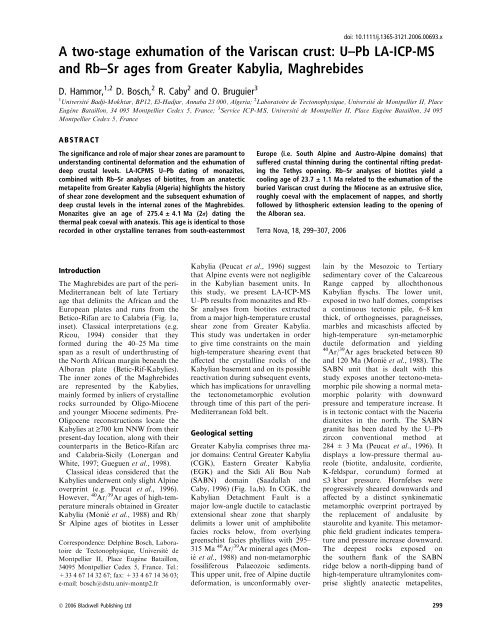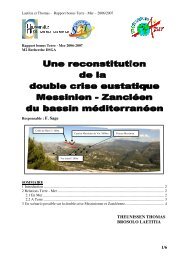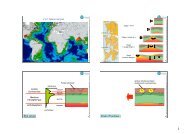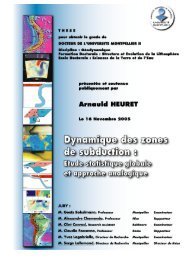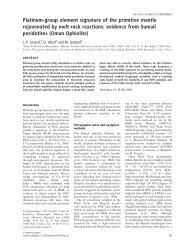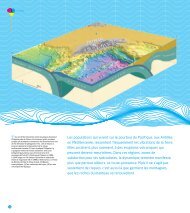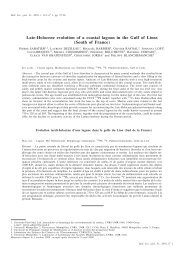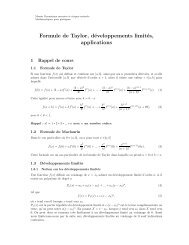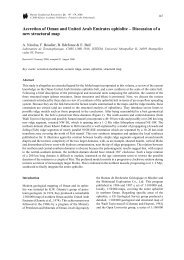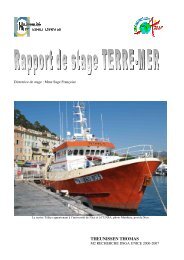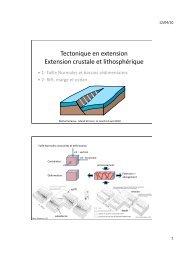Géochronologie U-Pb par ablation laser et ICP-MS (LA-ICP-MS ...
Géochronologie U-Pb par ablation laser et ICP-MS (LA-ICP-MS ...
Géochronologie U-Pb par ablation laser et ICP-MS (LA-ICP-MS ...
Create successful ePaper yourself
Turn your PDF publications into a flip-book with our unique Google optimized e-Paper software.
doi: 10.1111/j.1365-3121.2006.00693.x<br />
A two-stage exhumation of the Variscan crust: U–<strong>Pb</strong> <strong>LA</strong>-<strong>ICP</strong>-<strong>MS</strong><br />
and Rb–Sr ages from Greater Kabylia, Maghrebides<br />
D. Hammor, 1,2 D. Bosch, 2 R. Caby 2 and O. Bruguier 3<br />
1 Universite´ Badji-Mokhtar, BP12, El-Hadjar, Annaba 23 000, Algeria; 2 Laboratoire de Tectonophysique, Universite´ de Montpellier II, Place<br />
Euge`ne Bataillon, 34 095 Montpellier Cedex 5, France; 3 Service <strong>ICP</strong>-<strong>MS</strong>, Universite´ de Montpellier II, Place Euge`ne Bataillon, 34 095<br />
Montpellier Cedex 5, France<br />
ABSTRACT<br />
The significance and role of major shear zones are <strong>par</strong>amount to<br />
understanding continental deformation and the exhumation of<br />
deep crustal levels. <strong>LA</strong>-<strong>ICP</strong><strong>MS</strong> U–<strong>Pb</strong> dating of monazites,<br />
combined with Rb–Sr analyses of biotites, from an anatectic<br />
m<strong>et</strong>apelite from Greater Kabylia (Algeria) highlights the history<br />
of shear zone development and the subsequent exhumation of<br />
deep crustal levels in the internal zones of the Maghrebides.<br />
Monazites give an age of 275.4 ± 4.1 Ma (2r) dating the<br />
thermal peak coeval with anatexis. This age is identical to those<br />
recorded in other crystalline terranes from south-easternmost<br />
Europe (i.e. South Alpine and Austro-Alpine domains) that<br />
suffered crustal thinning during the continental rifting predating<br />
the T<strong>et</strong>hys opening. Rb–Sr analyses of biotites yield a<br />
cooling age of 23.7 ± 1.1 Ma related to the exhumation of the<br />
buried Variscan crust during the Miocene as an extrusive slice,<br />
roughly coeval with the emplacement of nappes, and shortly<br />
followed by lithospheric extension leading to the opening of<br />
the Alboran sea.<br />
Terra Nova, 18, 299–307, 2006<br />
Introduction<br />
The Maghrebides are <strong>par</strong>t of the peri-<br />
Mediterranean belt of late Tertiary<br />
age that delimits the African and the<br />
European plates and runs from the<br />
B<strong>et</strong>ico-Rifan arc to Calabria (Fig. 1a,<br />
ins<strong>et</strong>). Classical interpr<strong>et</strong>ations (e.g.<br />
Ricou, 1994) consider that they<br />
formed during the 40–25 Ma time<br />
span as a result of underthrusting of<br />
the North African margin beneath the<br />
Alboran plate (B<strong>et</strong>ic-Rif-Kabylies).<br />
The inner zones of the Maghrebides<br />
are represented by the Kabylies,<br />
mainly formed by inliers of crystalline<br />
rocks surrounded by Oligo-Miocene<br />
and younger Miocene sediments. Pre-<br />
Oligocene reconstructions locate the<br />
Kabylies at ‡700 km NNW from their<br />
present-day location, along with their<br />
counter<strong>par</strong>ts in the B<strong>et</strong>ico-Rifan arc<br />
and Calabria-Sicily (Lonergan and<br />
White, 1997; Gueguen <strong>et</strong> al., 1998).<br />
Classical ideas considered that the<br />
Kabylies underwent only slight Alpine<br />
overprint (e.g. Peucat <strong>et</strong> al., 1996).<br />
However, 40 Ar/ 39 Ar ages of high-temperature<br />
minerals obtained in Greater<br />
Kabylia (Monie´ <strong>et</strong> al., 1988) and Rb/<br />
Sr Alpine ages of biotites in Lesser<br />
Correspondence: Delphine Bosch, Laboratoire<br />
de Tectonophysique, Université de<br />
Montpellier II, Place Eugène Bataillon,<br />
34095 Montpellier Cedex 5, France. Tel.:<br />
+33 4 67 14 32 67; fax: +33 4 67 14 36 03;<br />
e-mail: bosch@dstu.univ-montp2.fr<br />
Kabylia (Peucat <strong>et</strong> al., 1996) suggest<br />
that Alpine events were not negligible<br />
in the Kabylian basement units. In<br />
this study, we present <strong>LA</strong>-<strong>ICP</strong>-<strong>MS</strong><br />
U–<strong>Pb</strong> results from monazites and Rb–<br />
Sr analyses from biotites extracted<br />
from a major high-temperature crustal<br />
shear zone from Greater Kabylia.<br />
This study was undertaken in order<br />
to give time constraints on the main<br />
high-temperature shearing event that<br />
affected the crystalline rocks of the<br />
Kabylian basement and on its possible<br />
reactivation during subsequent events,<br />
which has implications for unravelling<br />
the tectonom<strong>et</strong>amorphic evolution<br />
through time of this <strong>par</strong>t of the peri-<br />
Mediterranean fold belt.<br />
Geological s<strong>et</strong>ting<br />
Greater Kabylia comprises three major<br />
domains: Central Greater Kabylia<br />
(CGK), Eastern Greater Kabylia<br />
(EGK) and the Sidi Ali Bou Nab<br />
(SABN) domain (Saadallah and<br />
Caby, 1996) (Fig. 1a,b). In CGK, the<br />
Kabylian D<strong>et</strong>achment Fault is a<br />
major low-angle ductile to cataclastic<br />
extensional shear zone that sharply<br />
delimits a lower unit of amphibolite<br />
facies rocks below, from overlying<br />
greenschist facies phyllites with 295–<br />
315 Ma 40 Ar/ 39 Ar mineral ages (Monie´<br />
<strong>et</strong> al., 1988) and non-m<strong>et</strong>amorphic<br />
fossiliferous Palaeozoic sediments.<br />
This upper unit, free of Alpine ductile<br />
deformation, is unconformably overlain<br />
by the Mesozoic to Tertiary<br />
sedimentary cover of the Calcareous<br />
Range capped by allochthonous<br />
Kabylian flyschs. The lower unit,<br />
exposed in two half domes, comprises<br />
a continuous tectonic pile, 6–8 km<br />
thick, of orthogneisses, <strong>par</strong>agneisses,<br />
marbles and micaschists affected by<br />
high-temperature syn-m<strong>et</strong>amorphic<br />
ductile deformation and yielding<br />
40 Ar/ 39 Ar ages brack<strong>et</strong>ed b<strong>et</strong>ween 80<br />
and 120 Ma (Monie´ <strong>et</strong> al., 1988). The<br />
SABN unit that is dealt with this<br />
study exposes another tectono-m<strong>et</strong>amorphic<br />
pile showing a normal m<strong>et</strong>amorphic<br />
polarity with downward<br />
pressure and temperature increase. It<br />
is in tectonic contact with the Naceria<br />
diatexites in the north. The SABN<br />
granite has been dated by the U–<strong>Pb</strong><br />
zircon conventional m<strong>et</strong>hod at<br />
284 ± 3 Ma (Peucat <strong>et</strong> al., 1996). It<br />
displays a low-pressure thermal aureole<br />
(biotite, andalusite, cordierite,<br />
K-felds<strong>par</strong>, corundum) formed at<br />
£3 kbar pressure. Hornfelses were<br />
progressively sheared downwards and<br />
affected by a distinct synkinematic<br />
m<strong>et</strong>amorphic overprint portrayed by<br />
the replacement of andalusite by<br />
staurolite and kyanite. This m<strong>et</strong>amorphic<br />
field gradient indicates temperature<br />
and pressure increase downward.<br />
The deepest rocks exposed on<br />
the southern flank of the SABN<br />
ridge below a north-dipping band of<br />
high-temperature ultramylonites comprise<br />
slightly anatectic m<strong>et</strong>apelites,<br />
Ó 2006 Blackwell Publishing Ltd 299


